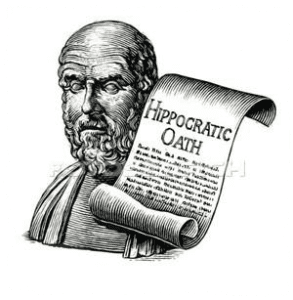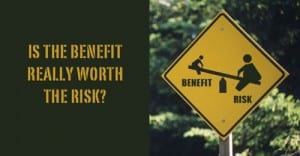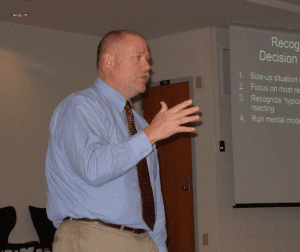
Primum non nocere is the Latin phrase that means “first, do no harm.” This is a commonly taught principle in healthcare. In fact, the Hippocratic Oath, taken by doctors, promises they will abstain from doing harm to their patients. The premise is it may be better to NOT do something or to do nothing at all at the risk of causing more harm than good. Let’s explore how Primum non nocere might apply to emergency scene decision making.
Risk versus benefit
The work that first responders perform is risky. That is indisputable, and to some extent, unavoidable. The mission of first responders is primarily, to the best of our abilities, to save lives and property. Education, training, fitness, experience and equipment are among the assets that help responders succeed in the mission of saving lives and property.
 However, not all lives and property are savable. Regardless of how well-educated, how well-trained, how fit, how experienced or how well provisioned a responder is, there will be times when circumstances are beyond our control and no matter what we would try to do, the outcome will be bad.
However, not all lives and property are savable. Regardless of how well-educated, how well-trained, how fit, how experienced or how well provisioned a responder is, there will be times when circumstances are beyond our control and no matter what we would try to do, the outcome will be bad.
The challenge is for responders to conduct an assessment of the situation and make decisions that first, do no harm. And this means to the responders as well. When a responder makes entry into a fire environment and, within two minutes, suffers a catastrophic consequence as a result of a flashover or a floor collapse, it raises questions about the risk being taken versus the benefit of the action.
Decision making
Sadly, most first responders are not taught the process for how to make a high-risk, high consequence decision. A great deal of time is spent teaching the basics on how equipment is used and how to apply tactics. But very little time is spent teaching responders how to develop and maintain situational awareness and how to use situational awareness as the foundation for good decision making.

A decision is simply a choice made among alternatives. In fact, in order to make a decision, there must always be at least two decision options to choose from. Of course, there always are at least two options because whenever you are faced with any action, you have the option to do nothing. Thus, you always have decisions to make at emergency scenes.
Teaching decision making
So far, it all seems so simple. Do no harm and make the best decision among alternatives. But what happens, sadly, in some first responder training programs is the recruits are not taught how to make decisions and in some cases, personal harm (to the responders) is not discussed as an essential component of making sound decisions.
in some first responder training programs is the recruits are not taught how to make decisions and in some cases, personal harm (to the responders) is not discussed as an essential component of making sound decisions.
For example, when recruits are taken to the burn building, the instructional team lights the fire and then calls for the team to make entry to fulfill the mission (save lives and property). In many, many cases it is the INSTRUCTOR who makes the decision for the students to enter the structure and commence with the search or fire attack – not the student. (I know. As an instructor I’ve made this mistake myself. I’ve also interviewed hundreds of students whose instructors have done the same thing and I have interviewed hundreds of instructors who’ve made the same admission about their teaching methods).
The focus is almost always on the physical aspects of firefighting. The lessons usually revolve around:
- How to stay low in smoke.
- How to advance the line.
- How to search for victims.
- How to maintain orientation.
- How to remove a victim.
- How to extinguish the fire.
This is not an exhaustive list, nor is it intended to be. It simply serves as an example of the hands-on tasks the recruits will be taught during a live burn exercise. But what about decision making skills?
The instructor who ordered the recruits to make entry and commence the mission… robbed the recruits of the opportunity to make the first, and arguably, most important decision to be made at a structure fire – Go or No-Go.
In fact, in the training evolutions I have participated in (and interviewed others who have conducted and participated in) the decision is always… ALWAYS… Go! And that decision is almost always made by the instructor, not the student.
 Rich Gasaway’s Advice
Rich Gasaway’s Advice
It should be the goal of every instructor (and parents of teenagers for that matter) to teach students (or teens) how to make their own decisions. This is done by teaching the process of decision making (including how situational awareness serves as the foundation for those decisions). Then, responders (and teens) need to practice decision making under the tutelage of the wise teacher.
For first responders, those decisions should include the maxim “First, do no harm.” Responders need to be taught how to conduct a quality size-up, capturing clues and cues about what is happening in their environment. Then they need to be taught how to assess those clues and cues into coherent meaning. And finally, they need to learn how to make accurate predictions of future events – in time to avoid bad outcomes.
Now, for anyone who’s been a student in one of my situational awareness classes, you know this can be much easier said than accomplished, especially when under stress, time compression and changing conditions. But it is a skillset that can (and should) be taught.
For the example above, it can be as simple as getting responders into the mindset that when they arrive on a scene (in this case the “scene” is the burn building) they must first conduct a size-up and form situational awareness about what is happening. This includes gathering information that might indicate conditions that will warrant a No-Go decision.
No-Go conditions can be difficult to replicate at a burn building (e.g., impending signs of flashover or collapse). But it can be done using simulation. [See previous articles on this site on the topic of using simulation software to improve fireground decision making. There are several low cost alternatives. My favorite is SimsUShare because it’s mobile friendly, easy to use and inexpensive.]
One of the decision criteria that should be on the mind of a responder during size-up is, “First, do no harm.” In this context, the “harm” is to the responders themselves. When we can get responders to a level of decision making where they realize there are alternatives AND they make their own decisions AND one of those decision options might be to (dare I say it) NOT go inside, then we begin to develop creative problem solvers… smart… thinking… responders.
As instructors, I would encourage you to become a student of situational awareness and learn the process for how to make high-risk, high consequence decisions and begin teaching your students how to make their own decisions and Primum non nocere.
Action items
 1. Discuss how responders are taught to make decisions in your organization.
1. Discuss how responders are taught to make decisions in your organization.
2. Observe how recruits are being taught in your academy (better yet, observe their training, if you are able).
3. Discuss the maxim, “First, do no harm” and how important it is to conduct a risk-benefit assessment prior to engaging in activities that can result in responder casualties.
_____________________________________________________

If you are interested in taking your understanding of situational awareness and high-risk decision making to a higher level, check out the Situational Awareness Matters Online Academy.
CLICK HERE for details, enrollment options and pricing.
__________________________________
Share your comments on this article in the “Leave a Reply” box below. If you want to send me incident pictures, videos or have an idea you’d like me to research and write about, contact me. I really enjoy getting feedback and supportive messages from fellow first responders. It gives me the energy to work harder for you.
Thanks,

Email: Support@RichGasaway.com
Phone: 612-548-4424
SAMatters Online Academy
Facebook Fan Page: www.facebook.com/SAMatters
Twitter: @SAMatters
LinkedIn: Rich Gasaway
YouTube: SAMattersTV
iTunes: SAMatters Radio

Dr. Gassaway, spot on with this article as well. The key here is size up and situational awareness, sometimes a commander becomes overwhelmed with what they see, so the focus is on incremental pieces not the whole picture. In my career as a chief officer and instructor, I find that sometimes the education individuals receive is minimal or non-existent to the level it should be for making major decisions, and that leaves individuals to pull on their minimal knowledge. I always talk about KSA’s but not all regions have the backgrounds and use the promotions bases solely on seniority, not the well versed with education. In our job, it is important to instill in our firefighters, that each step should have an educational criteria, because as we all know that one day we will be challenged, and the decisions we make may make the difference, for the better or worse. I also agree with mentoring the individuals to make sound decisions while they are even a rookie, because if they start looking early in their career, they should continue to look at situations overtime; hence second nature and comfortableness in their decisions will make the challenges easier.
Dr.Gasaway,
As someone with 34 years of public safety service as both a responder and a receptionist… um I mean 911 Telecommunicator (we wish the world would recognize us as first responders with equal treatment) I would like to say thank you! Your article brings to light something which is not tolerated in the majority of jobs which require licensure or certification for non-emergent positions and shouldn’t be for any job dealing with safety of responders and citizen alike. Proper decision making methods should be taught prior to equipment training to apply learned skills. I’d love to learn more about any training resources you may have. Keep fighting the good fight on behalf of everyone who needs or requests help.